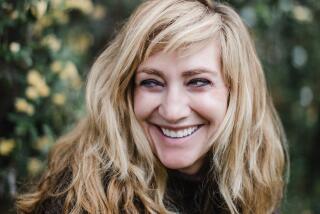Book Review : The Friends Hildegarde Flanner Recalls
Different Images, Portraits of Remembered People by Hildegarde Flanner (Daniel, P.O. Box 21922, Santa Barbara, Calif . 93121: $10; 112 pages)
No fabricated characters in a book of fiction, the three friends described in poet and essayist Hildegarde Flanner’s contemplative reminiscences are real people, as engaging, intriguing and memorable as any to be found in fiction.
The recollections begin with an introduction of how each came into her life, plus expertly worded descriptions of each character so that a visual image of the person about whom she writes is instantly drawn on the reader’s imagination.
Of Zoe Lennox, who Flanner befriended while living in the Napa Valley in the ‘70s, you think, “I know someone like that--beautiful, compelling and a bit strange.” You read on eagerly to see if there are more similarities between Zoe and your friend.
Recalls the writer, “. . . I thought of her as a season in herself, bright, too warm, windy, promising a rich harvest with festivals and the sweat of hard work, and burdened trucks on the highway full of sweet grapes. . . .” Through Flanner’s vivid imagery, and particularly her exceedingly acute recall of conversations that are humorous, personal and poignant, Zoe develops a distinct personality of her own. Her zaniness and her happy marriage become your joys; her divorce, a shared disappointment; her unexpected death, a sharp regret.
Madcap Zoe Is Gone
Too soon, madcap Zoe is gone. Yet, Flanner closes this narrative of Zoe with an epitaph that is eminently fitting and uplifting, one that brings an unexpected smile to pair with a lump in the throat.
Miss Olive Percival, another of Flanner’s remembered people, introduced the author to Pasadena society in the 1920s, and her long friendship with this wealthy spinster allows us not only an intimate study of their relationship, but also a glimpse at how the haut monde lived in those early days of California.
“In my diaries,” Flanner reports, “Miss Percival stands clear and strong, a little stout, perhaps, but a good shape, even queenly. Her head was always poised and her features composed. She could laugh without loss of dignity. I never saw her swept-back hair out of order in its combs.” Yet in a burst of candor and sophistication, particularly for those times, Miss Percival, a model of matrons, declares to her friend, “I believe I am the only virgin in Los Angeles County.” The statement followed a stretch of service on the Grand Jury that was particularly rich in broken promises and dirty drama, a strong indication that the ‘20s roared even in Pasadena.
In a stranger-than-fiction happenstance, the third recollected friend is fantasy illustrator Kay Neilson, whom Flanner greatly admired as a child. He came to California in 1936 at the invitation of the Festival Assn. of the Hollywood Bowl to do the scenic production for Max Reinhardt’s “Everyman.” He remained to work for Walt Disney, designing the ethereal “Bald Mountain” sequence for “Fantasia.” Most remarkably, the artist became the author’s neighbor in Altadena in the ‘40s. But the far stronger personality in this related love story is Neilson’s wife, Ulla, an extraordinary heroine who endures her husband’s successes, setbacks and failures with great elan and courage, always putting her artist-husband’s welfare first and shielding him physically and mentally so that he could work and create without distraction.
“It did not require a long acquaintance to reveal that Ulla’s love for her husband was the emotional and practical apparatus that ran their lives. To love a man as she did was not only utter devotion but an enterprise to which she gave inventive attention.” So devoted is Ulla to her husband that she chooses to join him in death a year later.
Flanner’s final recollection is that of her own stage-struck mother as she observed her as a small girl at the turn of the century. “My mother,” the author recalls, “was a conscientious woman who carried on the life of wife and mother at the same time she was laboring and hoping for an important career. She had been told so often that she was beautiful and talented and should be on the professional stage. She dreamed of it and lived with the image.”
Flanner arrived in Southern California in 1923, remaining for nearly 40 years. She recorded her perceptions of disturbing changes in Los Angeles during the 1940s in “A Vanishing Land” (No Dead Lines). Her books of poetry include “Young Girl and Other Poems” (Porter Garnett), “Valley Quail” (Ward Ritchie) and “If There Is Time” (New Directions). She moved to Calistoga in 1961 and spent the last years of her life there with her husband, architect/artist Frederick Monhoff. Her slender volume, “Brief Cherishing: A Napa Valley Harvest” (John Daniel, 1985) is a loving memoir of her marriage; in 1986, she published a collection of essays, “At the Gentle Mercy of Plants” (John Daniel).
Hildegarde Flanner died May 27, 1987, at age 87, just a few weeks before the publication of this, her final book of essays. (John Daniel will release “Poems: Collected and Selected,” a retrospective collection of Flanner’s work, including an introduction by Janet Lewis, in 1988.)
“To some people it would be of interest to learn I am the sister of Janet Flanner,” Flanner once commented. “She’s famous, you know.”
In describing her friends in “Different Images, Portraits of Remembered People,” Flanner writes, “Their lives touched ours, touched, grazed and left a mark, a groove, and in it the needle of my memory goes around and around. For me, the sound it makes is elegy, harmonious, melancholy or funny.” For the reader, it is the same sound.
More to Read
Sign up for our Book Club newsletter
Get the latest news, events and more from the Los Angeles Times Book Club, and help us get L.A. reading and talking.
You may occasionally receive promotional content from the Los Angeles Times.






